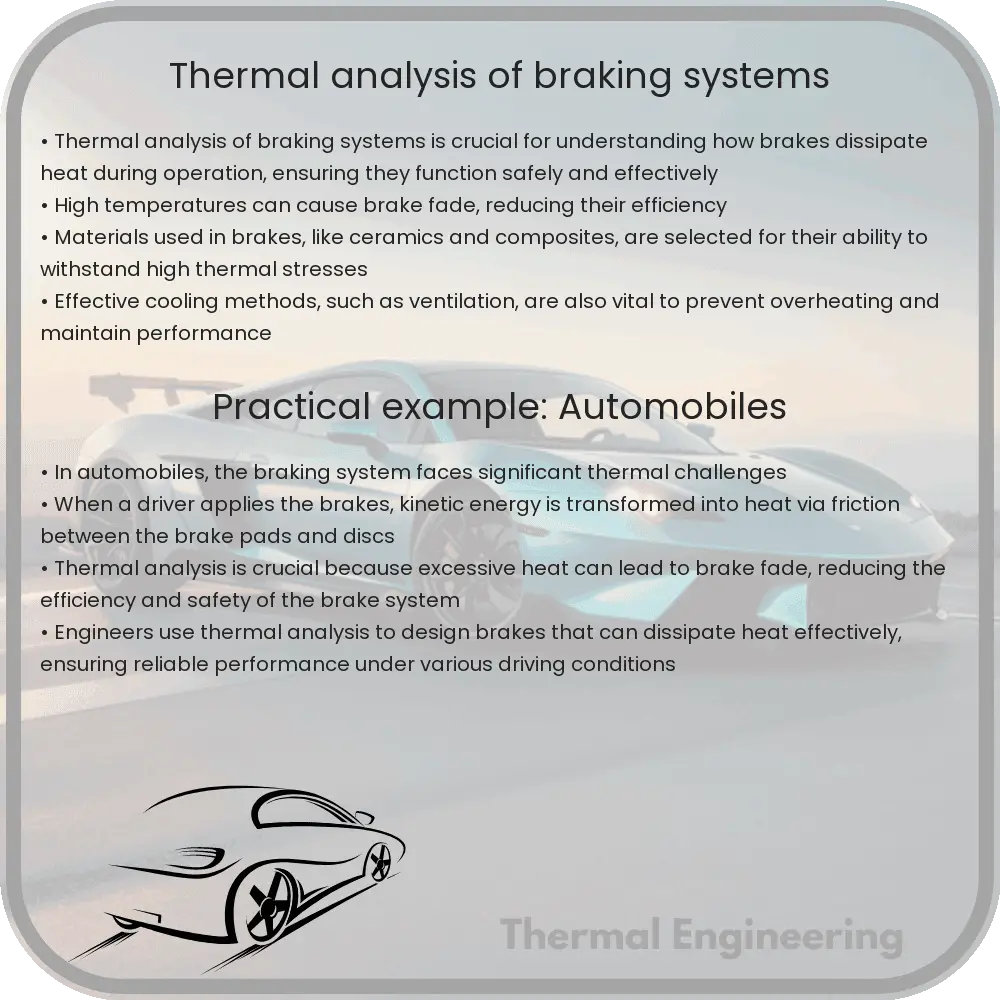This article examines thermal analysis in braking systems, focusing on heat generation, dissipation, and the impact on safety and performance in vehicles.

Thermal Analysis of Braking Systems
Understanding the thermal performance of braking systems is crucial in the design and safety of automotive and aeronautical engineering. As a vehicle brakes, kinetic energy – due to the vehicle’s motion – is transferred into thermal energy due to friction, significantly increasing the temperature of the braking system. This article explores the basics of thermal analysis applied to braking systems, explaining how heat generation and dissipation impact system performance and safety.
Heat Generation in Brakes
The primary source of heat generation in braking systems is the friction between the brake pad and the rotating disc. When the brake pedal is pressed, hydraulic or mechanical force clamps these brake pads onto spinning rotors (or drums in some vehicles), generating friction. This friction converts kinetic energy from the vehicle’s motion into heat. The amount of heat generated is directly proportional to the vehicle’s mass and the square of its velocity, making high-speed or heavy vehicles particularly susceptible to high brake temperatures.
The basic equation governing this conversion is:
\[ Q = μ * N * v * d \]
Where:
- Q is the heat generated
- μ is the coefficient of friction between the pad and the rotor
- N is the normal force
- v is the relative velocity between the braking surfaces
- d is the distance over which the force is applied
Heat Transfer and Dissipation
Once heat is generated, the braking system must transfer and dissipate it effectively into the surrounding environment to prevent overheating, which could lead to brake fade or failure. There are three main modes of heat transfer: conduction, convection, and radiation.
- Conduction occurs between materials that are in direct contact. Within the braking system, heat is conducted from the pads into the rotors and then to the surrounding air.
- Convection is the transfer of heat by the motion of fluids. The air flowing over the surface of the brakes as the vehicle moves helps to remove heat from the surface of the rotors.
- Radiation is the transfer of heat through electromagnetic waves. Hotter components of the braking system, like rotors, can radiate heat to cooler parts such as calipers and nearby suspension components.
Effective thermal management in braking systems can involve the use of materials with high thermal conductivity for brake components, such as certain ceramics or composites, and/or the design of the components to maximize surface area for better heat dissipation.
Modeling and Simulation in Thermal Analysis
The development of reliable braking systems often involves sophisticated modeling and simulation. Engineers use computational fluid dynamics (CFD) and finite element analysis (FEA) to predict how different designs will perform under thermal stress and to optimize brake systems for heat dissipation. These simulations help in understanding how changes in design variables, like the thickness of the brake disc or the type of materials used, influence the system’s thermal performance.
Safety Considerations
Keeping the temperatures within safe limits prevents brake fade, where higher temperatures cause a reduction in friction between the pad and the rotor, and as a result, reduced braking effectiveness. This scenario highlights why thermal analysis is fundamental to the design and safety assurance of braking systems.
Moreover, sustained high temperatures can lead to the premature wear and failure of braking components, raising maintenance costs and safety risks. Hence, engineers strive to design brakes not only to withstand the mechanical pressures of stopping a vehicle but also to manage and dissipate heat efficiently under varying operating conditions.
Conclusion
The thermal analysis of braking systems encapsulates a critical aspect of vehicle safety and performance engineering. Through careful consideration of materials, design and thermal properties, engineers can ensure that the brakes perform reliably in all conditions, protecting vehicle integrity and occupant safety. Sustained research and innovation are imperative to meet the evolving demands of modern transportation and to handle the high-performance expectations from braking systems.